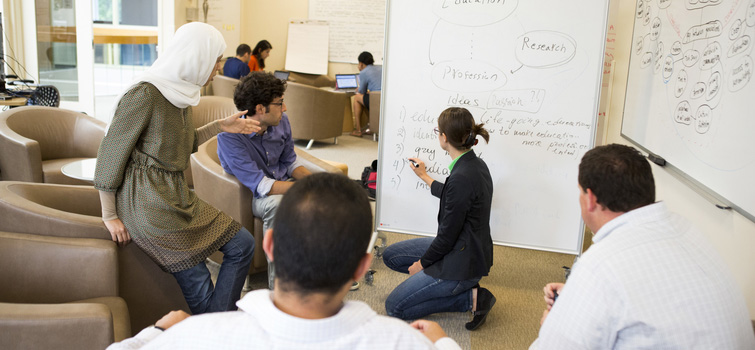
Bias influences our every decision.
Hiring a new employee, deciding who to sit next to in class, even choosing a meal at a restaurant: All actions are influenced by our past experiences and personal preferences.
“The danger in our thinking is that we believe we’re fully aware of why we’re doing what we’re doing; however, there are always invisible factors influencing our thinking” says Wiley Davi, associate professor of English and Media Studies at Bentley University. She teaches a course called “Thinking about Thinking” in the Bentley MBA program’s Leadership module, the first of four in the 11-month program.
She and her fellow instructor Professor Duncan Spelman use simulations and class discussions to show students the factors which influence their thinking, which in turn influences their behavior.
It’s a course about metacognition, or paying attention to our cognitive processes. And it’s essential to effective leadership.
Bias and Our Understanding of the World
There are two types of bias: explicit and implicit. Explicit bias is easy to spot, such as when a leader readily admits to preferring American-owned companies or hiring students who hail from her alma mater.
Implicit, or unconscious, bias is more insidious.
“I can be the best, most well-intentioned person in the world,” says Davi, “but given my past experiences . . . there may be patterned ways of thinking that I’ve inherited that could influence my thinking without me actually being conscious of it.”
She says our brain creates a shorthand to decipher the vast amount of information we absorb every moment. Our unconscious notices every last detail, down to the sound of the dishwasher in the next room.
Our mind, however, makes snap judgments to determine the most vital information. This shorthand is based on a number of factors; in their course, Davi and Spelman focus on what they see as four key factors: emotional intelligence, social identity, your brain’s drive for certainty, and “out of awareness,” or activity happening in your brain that you don’t notice.
As future leaders, the MBA students learn how to recognize each factor at play in order to mitigate the negative impact of bias.
Developing Processes to Eliminate Bias
Davi explains that unconscious bias isn’t inherently evil. For example, when we go to restaurants the fonts on the menu and the lighting in pictures can influence our choice of one meal over another, helping us make a decision quicker.
However, when left unchecked, that same influence can become harmful. For example, before blind auditions became the norm in the 1970-’80s, orchestras were made up of primarily male musicians. Once they began holding blind auditions, new members were chosen on talent alone, increasing the number of women represented.
The class is designed to teach students to create similar processes to avoid bias in their work. Davi puts the students into simulations, such as leading a team in a decision-making process, in order to help them learn to spot the four factors at play.
Emotions Role in Effective Leadership
To help students begin to pay attention to influencing factors such as emotions or social identities, Davi and Spelman put them into a number of simulations. In addition, they use fiction as a way to trigger certain responses. For example, students are often baffled by being assigned a short story by Milan Kundera in an MBA leadership course. However, by the end of the discussion of the reading, they come to recognize the complex ways in which their emotional reactions influenced their understanding of the characters and the story.
“Leaders shouldn’t be reluctant or afraid to pay attention to how emotions are influencing their thinking,” she says. “It can be really useful data.”
A New Kind of Leader
“Thinking about Thinking” creates a new kind of leader.[[{"fid":"301126","view_mode":"default","fields":{"format":"default"},"type":"media","attributes":{"alt":"4 Ways to Make Better Decisions at Work","style":"float: right;","class":"media-element file-default"}}]]
For too long, “leader mode” simply meant work hard and fast and be the best. A more effective leader, Davi argues, is reflective.
“Unless your deadline is two minutes from now, pause.” Give yourself 15 minutes before replying to a rude email or spend a few days considering a candidate for a job.
By taking a moment to think, leaders stop reacting on instinct, which would force them to rely on their subconscious shorthand. Instead, they become more accepting, humble, and open to feedback.
The class is designed to create this type of leader by strengthening the students’ communication, intercultural, and critical-thinking skills. Those who have completed the module tell Davi that the lessons they learned have given them stronger interpersonal skills and allow them to manage teams better.
Now, Davi and Spelman are hoping to continue to change the world’s perception of an effective leader by writing a book, sharing some of the lessons they teach. They hope the book will inspire leaders to incorporate these lessons into their daily lives, not just a day-long corporate workshop or a 10-week MBA course.
Learning to think this way is a lifelong process, says Davi. When we stop thinking about the way we think, we fall into old biases. Executive teams at businesses continue to look the same, and we miss out on valuable perspectives from women and minorities.
“The only person you can change is yourself. So the more you think about your own thinking, the better the outcome in any situation.”

